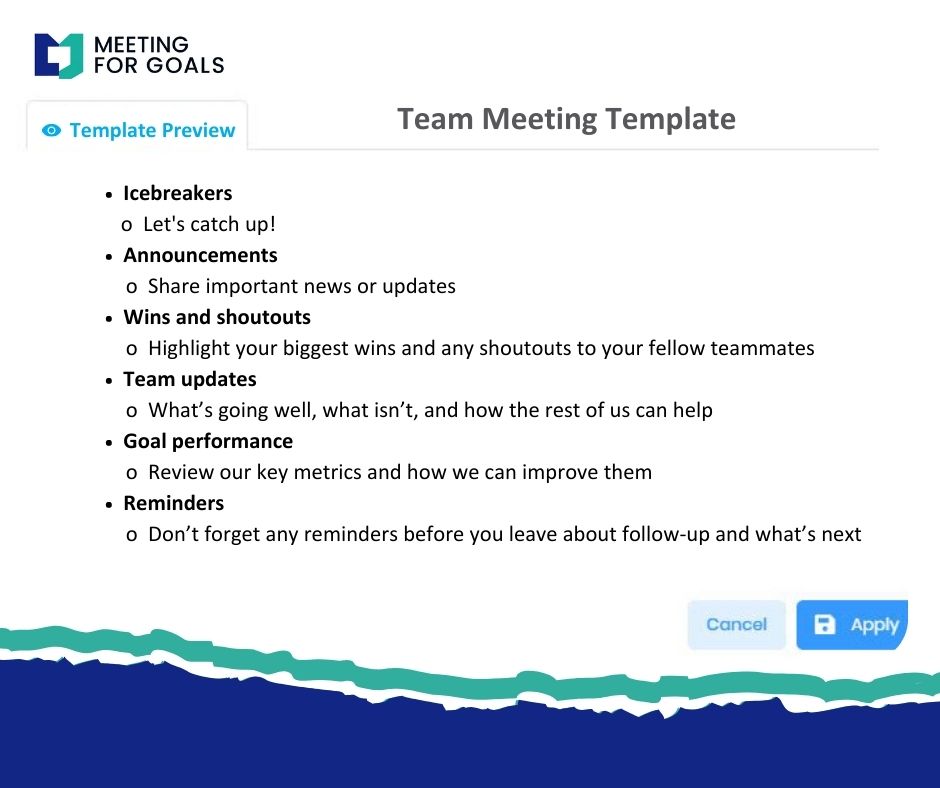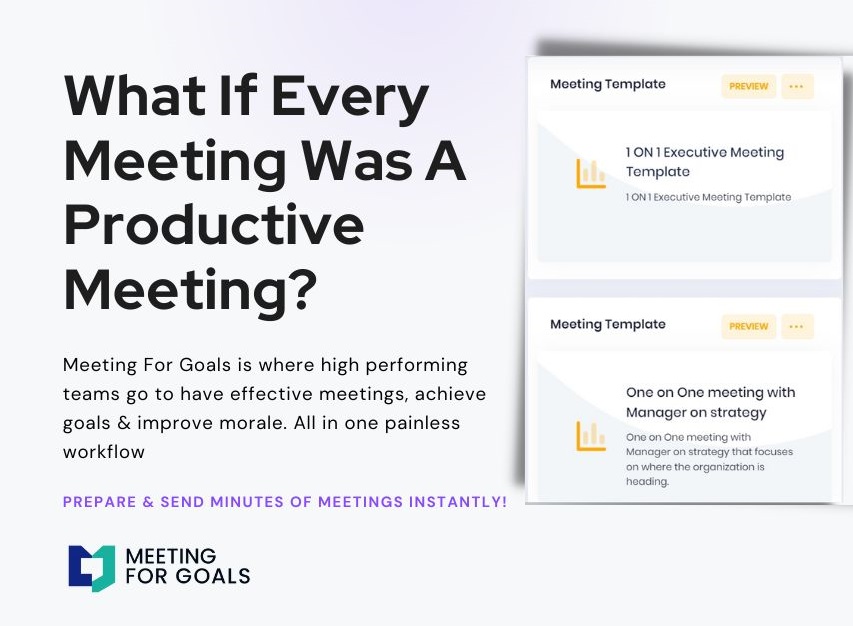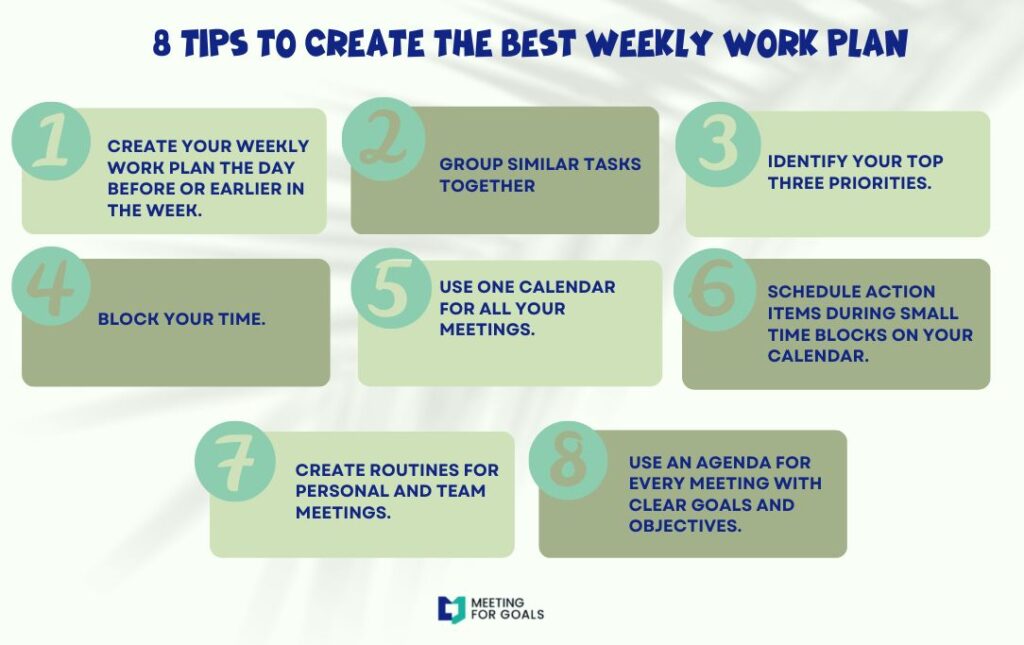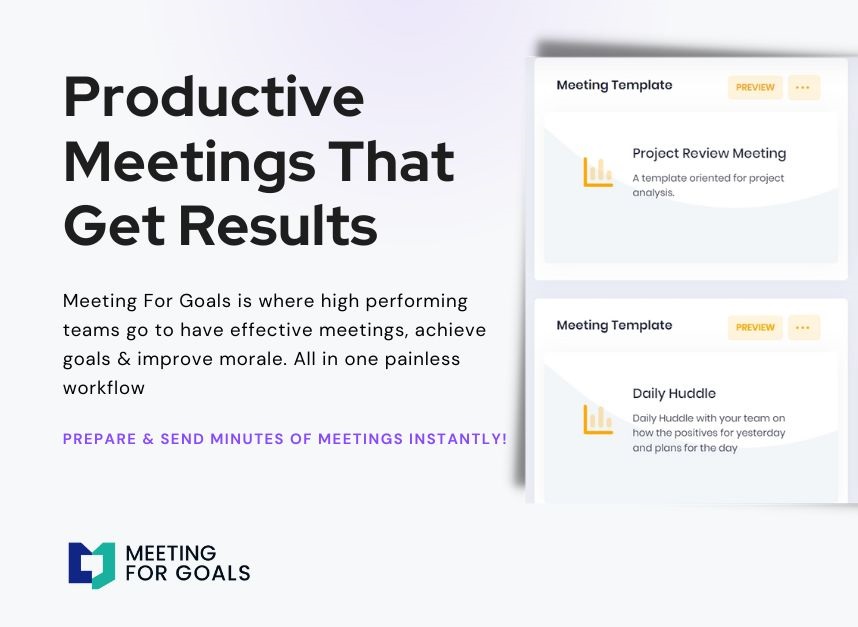The Power of the Weekly Check-In: A Strategic Tool for High-Performing Teams
In today’s fast-paced business world, staying aligned and productive as a team is more important than ever. One simple yet powerful strategy that high-performing companies are using is the weekly check-in. These aren’t just your average meetings—they’re strategic moments that help teams stay accountable, focused, and connected.
If your company has between 40 and 70 employees, you’re in a sweet spot: big enough to need structure, but still agile enough to pivot quickly. That’s where weekly check-ins shine. In this guide, we’ll break down how to make weekly check-ins work for your team, how to structure them for success, and how tools like Meeting For Goals can take them to the next level.
👉 Want to get started fast? Explore our free meeting templates to save time and boost team alignment.
2 Minute Video
Watch a 2 minute demo of our meeting management software in action
Why Weekly Check-Ins Matter
As your team grows, keeping everyone on the same page gets harder. Miscommunication, missed deadlines, and unclear priorities can slow you down. Weekly check-ins help solve this by creating a consistent space where teams can:
- Share updates
- Highlight wins
- Tackle roadblocks
- Align on what’s next
Unlike long, drawn-out meetings, check-ins are short, focused, and action-oriented.
At Meeting For Goals, we believe every meeting should move your team closer to its goals. That’s why our platform is built to help you plan, run, and follow up on meetings—all in one place. Weekly check-ins are a perfect fit for this approach.
If you’re a manager, director, or executive, weekly check-ins can be a game-changer. They give you visibility into progress, help you spot issues early, and make sure your team is always aligned with company objectives.
Want to try it out? Sign up for Meeting For Goals now and start transforming your meetings.
Adding an Agenda
How to add an agenda instantly on Meeting For Goals
The Benefits of Weekly Check-Ins
Weekly check-ins might seem simple, but when done right, they can deliver big returns. Let’s look at the main benefits:
Boosting Productivity
Weekly check-ins keep your team focused on what really matters. Instead of spending time on low-priority tasks, your team gets a weekly reminder of top goals and how their work contributes to them.
This regular rhythm helps teams stay on track. It also cuts down on unnecessary meetings. When everyone knows there’s a set time to check in, there’s less need for constant updates.
A study by Atlassian found that the average employee attends 62 meetings a month, with half considered a waste of time. Weekly check-ins, when structured properly, can reduce this clutter and improve focus.
Fostering Accountability
When people know they’ll be reporting back each week, they’re more likely to follow through. Weekly check-ins create a culture of ownership.
For leaders, this is a huge advantage. You can quickly see who’s on track, who needs support, and where projects might be stuck. It also makes performance reviews easier since you have a weekly record of progress.
Enhancing Communication
Communication breakdowns are one of the biggest barriers to team success. Weekly check-ins provide a regular space for open dialogue.
They’re not just about reporting—they’re about listening. Team members can share insights, raise concerns, and get feedback in real time.
This helps build trust and transparency. When people feel heard, they’re more engaged—and more productive.
Setting Up Effective Weekly Check-Ins
A successful weekly check-in doesn’t happen by accident. It takes planning, structure, and consistency. Here’s how to do it right:
Define a Clear Agenda
Every check-in should follow a simple, repeatable structure. This keeps the meeting focused and ensures nothing important gets missed.
A solid agenda might include:
- Wins and accomplishments
- Progress on goals or KPIs
- Roadblocks or challenges
- Priorities for the upcoming week
- Open discussion or feedback
Using a tool like Meeting For Goals makes it easy to create and share agendas ahead of time. Everyone comes prepared, and the meeting runs smoothly.
Prepare in Advance
Encourage your team to update their progress before the meeting. This cuts down on “status dump” time and allows for more meaningful discussion.
With Meeting For Goals, team members can enter updates directly into the platform. That way, you can spend the meeting talking about what matters—solving problems and planning next steps.
Choose the Right Frequency and Length
Weekly is usually the sweet spot. It’s frequent enough to stay aligned, but not so often that it becomes a burden.
Aim for 30 to 45 minutes. Keep it short and focused. If deeper issues come up, schedule separate follow-ups.
Assign Roles
Every check-in should have:
- A facilitator (usually the team lead or manager)
- A note-taker (or use software to automate this)
- Clear accountability for follow-ups
Meeting For Goals automatically tracks action items, so nothing falls through the cracks.
Key Components of a Successful Check-In
Even with the right structure, your check-ins need a few key ingredients to be truly effective:
- Review and Reflect
Start by looking back at the previous week. What got done? What went well? What didn’t?
This isn’t just about accountability—it’s about learning. Celebrate wins, but also talk about what could be improved.
- Address Roadblocks
Next, surface any blockers. Is someone waiting on a decision? Are there resource gaps?
This is your chance to fix issues before they become bigger problems.
With Meeting For Goals, you can tag blockers, assign them to team members, and track resolution over time.
- Set Priorities
Now look ahead. What are the top 3–5 priorities for the coming week? Who’s doing what?
Clear priorities help your team stay focused and avoid overcommitting.
- Encourage Feedback
Check-ins aren’t just for managers to talk. Invite your team to share ideas, ask questions, and give feedback.
This creates a culture of openness and collaboration. It also helps uncover blind spots you might not see otherwise.
- Summarize and Document
Always end with a recap: what was decided, who’s doing what, and when it’s due.
Meeting For Goals creates automatic summaries and sends reminders, so your team stays on track.
Using Meeting Management Software
Manual meeting management is time-consuming and error-prone. That’s where meeting software comes in.
Meeting For Goals was built specifically for teams who want better meetings—without the hassle.
Here’s how it helps:
Streamline Prep and Follow-Up
Create recurring templates, send agendas in advance, and collect updates before the meeting even starts.
This saves time and makes your meetings more strategic.
Collaborate in Real Time
During the meeting, team members can comment on agenda items, update goals, and assign tasks—all in one place.
Everything is tracked, so there’s no confusion later.
Track Performance
Our platform includes analytics that show how your team is doing over time. You can see trends, identify bottlenecks, and make data-driven decisions.
Real-World Results
One of our clients—a 60-person tech startup—started using Meeting For Goals for their weekly check-ins. Within three months, they:
- Cut meeting time by 25%
- Increased goal completion by 40%
- Improved cross-team collaboration
It’s not just about saving time—it’s about getting better results.
Want to see similar results? Sign up now and start optimizing your team’s check-ins.
Overcoming Common Challenges
Even with the best tools, rolling out weekly check-ins can come with a few bumps. Here’s how to handle them:
“Another Meeting? Really?”
Some team members might resist the idea. They’re already busy—why add more?
The key is to explain the value. Show how check-ins save time in the long run by reducing confusion and rework.
Also, keep them short and useful. If people see value, they’ll show up.
Staying on Track
It’s easy for check-ins to go off the rails. To avoid this:
- Stick to the agenda
- Use a timer if needed
- Have a facilitator keep things moving
Meeting For Goals includes built-in time tracking and visual cues to help you stay on schedule.
Avoiding Overlap
If your team already has other meetings, check-ins can feel repetitive. The fix? Clearly define the purpose of each meeting.
Use check-ins for alignment and accountability. Use other meetings for brainstorming, planning, or deep dives.
Need help structuring your meetings? Check out our free meeting templates to get started.
Make Weekly Check-Ins Work for Your Team
Weekly check-ins are one of the simplest ways to boost team performance. They improve focus, strengthen communication, and build accountability.
For mid-sized companies, they’re the perfect balance of structure and flexibility. And with the right tools, they’re easy to implement.
Meeting For Goals is here to help. Our platform is designed to make meetings more effective, more efficient, and more impactful.
Ready to get started? Create your account today and see how weekly check-ins can transform your team.
👉 Sign up for Meeting For Goals
👉 Explore our free meeting templates
👉 Learn more at meetingforgoals.com
And if you’ve got a tip or success story about weekly check-ins, drop it in the comments—we’d love to hear from you!
External Resources:
- Want to learn more about effective team communication? Check out this guide from Harvard Business Review on How to Run a More Effective Meeting.
- For insights into improving accountability, explore this resource from Gallup on Building a Culture of Accountability.
Word Count: 2,072




